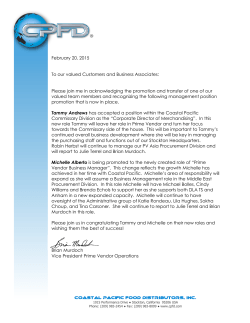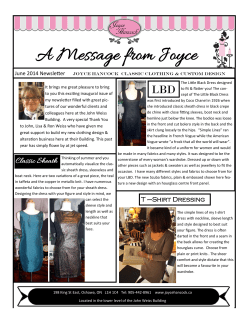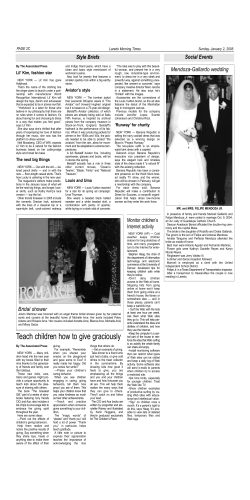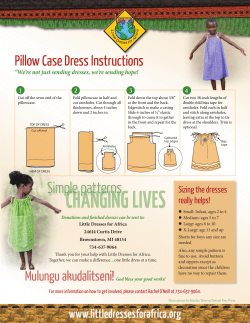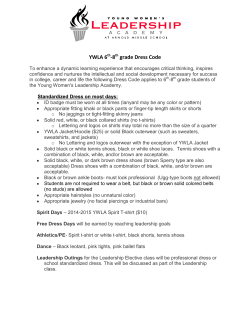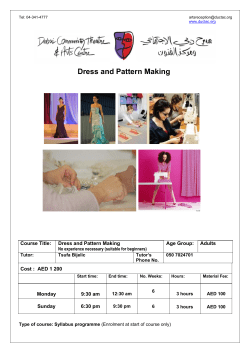
Case Study: Damsel in This Dress
Case Study: Damsel in This Dress What you will learn in this case study: • How to boost user engagement with online events. • How to increase product demand by using habit loop business principles. Who will find this report helpful: • Small business owners • Online retailers • Social media managers • Marketing executives MEET DAMSEL IN THIS DRESS Michelle Thorstrom, founder of Damsel in this Dress, has been building and selling corsets for over 10 years. Ranging from renaissance to pirate to victorian style, her corsets make regular appearances at renaissance festivals, Comic Con, and fantasy festivals across the country. Based in Utah, Michelle has inspired her eight-yearold daughter Brynn to open her own business featuring DIY products, Brynstarr. Passionate about entrepreneurship, Michelle empowers fellow small business owners with her enthusiasm and insights. THE PROBLEM With a niche audience and high quality products, Michelle chose Etsy as the online platform for expanding customer reach and increasing conversion sales. Unfortunately, Etsy failed Damsel in this Dress in a variety of ways. With its abundance of offerings, Damsel in this Dress used Etsy to sell grab bags. The popularity of these sales would regularly break Etsy’s backend system, and Damsel in this Dress would end up selling items that weren’t in its inventory. This was a big frustration for Michelle, knowing that she’d have to disappoint her fan base. “I feel like Etsy is the old boyfriend. And then you get married to this great guy, and you’re like, seriously, I ever loved that boyfriend?” Michelle Thorstrom, FOUNDER OF DAMSEL IN THIS DRESS THE SOLUTION Needed: An inventory management system, and dashboard with structure, consistency, and easyto-use insights. On Etsy, low-cost commercial products that sell for a fraction of the price are listed in the same category as Damsel in this Dresses. This affects the company’s ability to capture the sale, because in many cases, the consumer goes for the cheaper product over the detailed craftsmanship of handmade corsets. Needed: The ability to distinguish itself in its field. Overall, Etsy was just not a reliable sales channel for Damsel in this Dress. Frustrated with the many problems on Etsy, Michelle went looking for another platform to connect with her customers on an emotional level. After learning about Soldsie in the press, she knew social selling could be a key marketing and retail strategy for her company’s long-term growth. Michelle was delighted to work with Soldsie’s Social Success Team. Before her first sale, she educated her 15,000 Facebook fans about Soldsie through a variety of online marketing efforts. These included Facebook posts, blogs, videos, a giveaway, and a contest. THE RESULTS The outreach paid off, she made over $5,000 on her first sale -- she was hooked! Within three months of working with Soldsie, Damsel in this Dress generated over $100,000 in sales. This strategy has paid off big time. Over 70% of her sales come from returning customers, and 30% from new customers. In fact, five offshoot Facebook groups have popped up surrounding Damsel in this Dress’s corsets and products. Michelle is thrilled about her experience with Soldsie. She is constantly telling her family and friends about the value add she’s found with the company and product. Pinterest is the next frontier for Michelle, and she is already seeing incredible results. To further market Damsel in this Dress on Facebook, Michelle creatively named her sales “Hourglass Events” and time-capped them to drive conversions. She also created a “habit loop” with her Hourglass Events, making sure to announce a sale every Wednesday at 7 p.m. She increased demand leading up to each sale with fun promotions and coupons. “I want to bring in somewhere in the neighborhood of $20,000 a week with Soldsie alone. I really think we can hit it. I am not even afraid of that anymore. I feel like it’s totally possible.” Michelle Thorstrom, FOUNDER OF DAMSEL IN THIS DRESS ABOUT US Soldsie is the world’s first social shopping service. We help modern retailers grow their bottom line using Facebook and Instagram. Social shopping is the future of ecommerce — it’s more effective for retailers and a better experience for purchasers — and we’re going to power it.
© Copyright 2026

